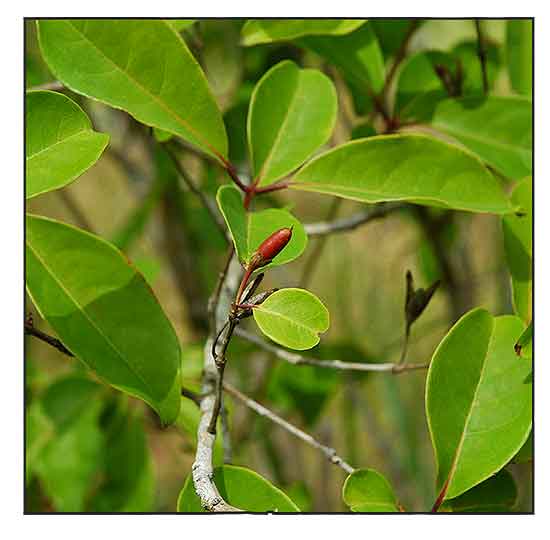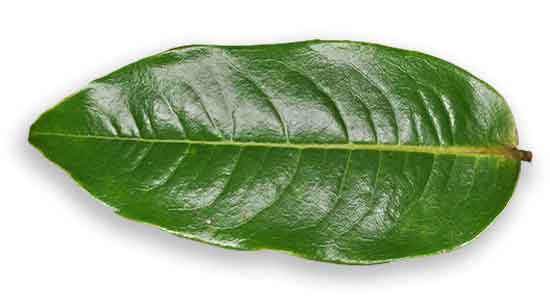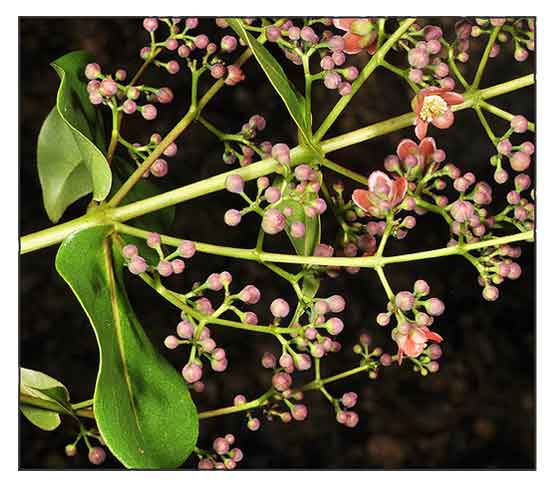
Family • Hypericaceae
Guyong-guyong
Cratoxylum sumatranum (Jack) Blume
PANAGULINGON
| Scientific names | Common names |
| Cratoxylum sumatranum (Jack) Blume | Alinggogon (Bik.) |
| Elodes sumatrana Jack | Bagatubang (S.L.Bis.) |
| Accepted infraspecifics (2) | Bansilai (C. Bis.) |
| Cratoxylum sumatranum subsp. blancoi (Blume) Gogelein | Baringkokoring (Ilk.) |
| Ancistrolobus micradenius Turcz. | Baringkukurung (Ilk.) |
| Caopia arborescens Kuntze | Bariuanuring (Ibn.) |
| Cratoxylum blancoi Blume | Barikokoroi (Ilk.) |
| Cratoxylum punctulatum Elmer ex Merr. | Biro (Neg.) |
| Hypericum coccineum Wall. | Goyong-goyong (Pang.) |
| Cratoxylum sumatranum subsp. sumatranum | Guyong-guyong (Tag.) |
| Ancistrolobus floribundus Turcz. | Kaminoringen (Ilk.) |
| Cratoxylum arboreum Elmer | Kansilai (P. Bis.) |
| Cratoxylum celebicum Blume | Kansilan (P.Bis.) |
| Cratoxylum clandestinum Blume | Kansilay (Bis.) |
| Cratoxylum floribundum (Turcz.) Fern.-Vill. | Kinay (C.Bis.) |
| Cratoxylum hornschuchii Blume | Kuelan (Ig.) |
| Cratoxylum hypericinum (Blume) Merr. | Kuttu (Ibn.) |
| Cratoxylum racemosum Blume | Lakandilay (Tag.) |
| Horschuchia hypericina Blume | Olingon (C. Bis, Mbo., Sul.) |
| Pagoriñgon (P. Bis.) | |
| Panaguliñgon (Tag.) | |
| Paguringon (Tag.) | |
| Paguringan (Mag.) | |
| Salinggogon (Tag.) | |
| Suilak (Ibn.) | |
| Ugingan (Ilk.) | |
| Uling (Ting.) | |
| Ulingon (C. Bis.) | |
| Ulingun (Mbo.) | |
| Uring (Bag.) | |
| Utto (Ibn.) | |
| Uugin (Ap.) | |
| Cratoxylum sumatranum (Jack) Blume is an accepted species. KEW: Plants of the World Online | |
| POWO lists two infraspecifics. Other sites list a third: C. sumatranum subsp. neriifolium (Kurz) Gogelein (Indo-china) | |
| Note: Panagulingon and Guyong-guyong merged. (G. Stuart : Sept 2023) | |
| Other vernacular names |
| BORNEO: Irat, Geronggang, Manding, Mentialing, Laka-laka, Serungan-mampat. |
| INDONESIAN: Salak gantung, Garinggang, Garunggang, Kemutun (Sumatra). |
| JAVA: Maron/g, Rinjung gide, Wuluan. |
| MALAYSIA: Deerum, Geronggang, Patok tilan. |
| SULAWESI: Kaju arang, Sisio pule. |
| THAILAND: Khee tiu, Tiu dam, Saliu. |
Updated September 2023 / October 2019 / March 2015
![]()
 |
PHOTOS / ILLUSTRATIONS |
| IMAGE SOURCE: Hypericaceae: Cratoxylum sumatranum / Fruiting twig / Copyright © 2011 by Leonardo L Co arcelona [ref. DOL32433] / Non-Commercial Use / click on image or link to go to source page / Phytoimages.siu.edu |
| OTHER IMAGE SOURCE: Hypericaceae: Cratoxylum sumatranum / Leaf / Copyright © 2017 by P B & J F Barcelona (contact: pieter.pelser@canterbury.ac.nz) [ref. DOL116507] / Non-Commercial Use / image modified / click on image or link to go to source page / Phytoimages.siu.edu |
| OTHER IMAGE SOURCE: Hypericaceae: Cratoxylum sumatranum / Branch of inflorescence / Copyright © 2017 by P B Pelser & J F Barcelona (contact: pieter.pelser@canterbury.ac.nz) [ref. DOL118771] / Non-Commercial Use / Non-commercial use / click on link or image to go to source page / Phytoimages.siu.edu |
| Additional
Sources and Suggested Readings Cratoxylum sumatranum / KEW: Plants of the World Online (1) Isolation and Structural Elucidation of New Xanthone from Rot Bark of Cratoxylum sumatranum / M.B.B. Buana, M. Iqbal, T.F. Barus, Z. Al-Fatony, H. Sudrajat and S. Khairi / Botany Research International 2 (4): 233-234, 2009 (2) Cytotoxic prenylated xanthones and the unusual compounds anthraquinobenzophenones from Cratoxylum sumatranum. / Seo EK, Kim NC, Wani MC, Wall ME, Navarro HA, Burgess JP, Kawanishi K, Kardono LB, Riswan S, Rose WC, Fairchild CR, Farnsworth NR, Kinghorn AD. / J Nat Prod. 2002; 65(3): pp 299-305. (3) Cratoxylum sumatranum / KEW: Plants of the World Online (4) Cratoxylum sumatranum (PROSEA) / MSM Sosef / Pl@ntUse (5) Cytotoxic prenylated xanthones and the unusual compounds anthraquinobenzophenones from Cratoxylum sumatranum. / Seo EK, Kim NC, Wani MC, Wall ME, Navarro HA, Burgess JP, Kawanishi K, Kardono LB, Riswan S, Rose WC, Fairchild CR, Farnsworth NR, Kinghorn AD. / J Nat Prod. 2002; pp 299-305 (6) Cratoxylum sumatranum stem bark exhibited antimalarial activity by Lactate Dehydrogenase (LDH) assay / Lidya Tumewu, Fendi Yoga Wardana, Hilkatul Ilmi, Adita Ayu Permanasari, Achmad Fuad Hafid, Aty Widyawaruyanti / J Basic Clin Physiol Pharmacol., 2021; 32(4): pp 817-822 / DOI: 10.1515/jbcpp-2020-0394 (7) New Benzophenones and Xanthones from Cratoxylum sumatranum ssp. neriifolium and Their Antibacterial and Antioxidant Activities / Cholpisut Tantapakul, Wisanu Maneerat, Tawanun Sripisut et al / J. Agric. Food Chem.201664468755-8762 / https://doi.org/10.1021/acs.jafc.6b03643 (8) In vitro Anti-Amebic Activity of Cage Xanthones from Cratoxylum sumatranum Stem Bark Against Entamoeba histolytica / Fendi Yoga Wardana, Defi Kartika Sari, Achmad Fuad Hafid et al / Pharmacognosy Journal, 2020, 12(3): pp 452-458 / DOI: 10.5530/pj.2020.12.70 (9) Aphrodisiac Activity of Ethanol Extract of Cratoxylum sumatranum (JACK) Blume Stems on Isolated Rat Corpus cavernosum / Sjarif Ismail, Mailiati Aminyoto / Journal of Tropical Pharmacy and Chemistry, 2018; 4(3) / DOI: 10.25026/jtpc.v4i3.150 (10) Ethnobotany of Medicinal Plants Used by the Subanen Tribe of Lapuyan, Zamboanga del Sur / Jhoan Rhea L Pizon, Olga M Nuñeza, Mylene M Uy, WTPSK Senarath / Bulletin of Environment, Pharmacology, and Life Sciences, 2016; 5(5): pp 53-67 / eISSN: 2277-1808 |
• |
DOI: It is not uncommon for links on studies/sources to change. Copying and pasting the information on the search window or using the DOI (if available) will often redirect to the new link page. (Citing and Using a (DOI) Digital Object Identifier) |
| List of Understudied Philippine Medicinal Plants |
| New plant names needed The compilation now numbers over 1,300 medicinal plants. I believe there are hundreds more that can be added to the collection. The last 100 plants came with great difficulty, many by happenstance, some by suggestion of site visitors. The basic information needed are the local plant name (if known), any known folkloric medicinal use, scientific name (most helpful), and, if possible, a photo. Your assistance will be greatly appreciated. |
• |
 |



 Uses
Uses 